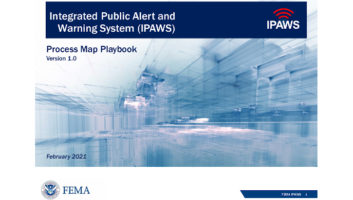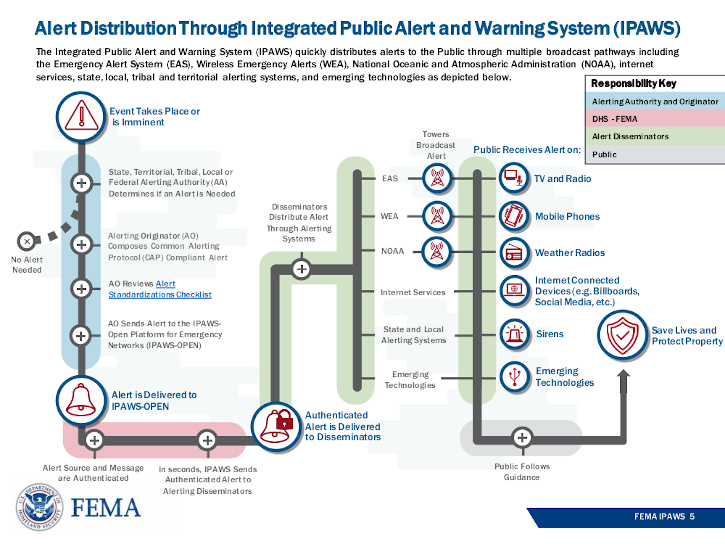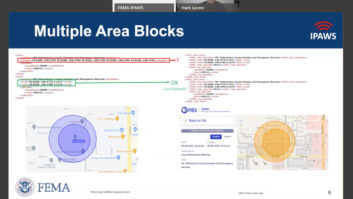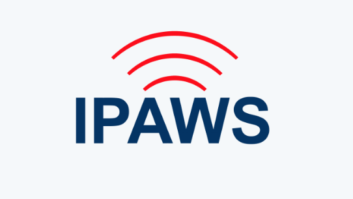 The Federal Emergency Management Agency has built a collection of online materials to help alert originators design successful emergency messaging procedures, which it hopes will ultimately increase the consistency and accuracy of alerting in the United States.
The Federal Emergency Management Agency has built a collection of online materials to help alert originators design successful emergency messaging procedures, which it hopes will ultimately increase the consistency and accuracy of alerting in the United States.
The IPAWS Programming Planning Toolkit currently contains five documents, including a recently completed Process Map Playbook. The playbook illustrates the interconnected processes at federal, state and local levels and is intended to streamline knowledge for the IPAWS alerting community, including broadcasters, according to FEMA.
[Read: SBE Issues Guidance About RWT Failure]
IPAWS, which stands for Integrated Public Alert and Warning System, is a network of systems used by alerting authorities to create geographically-targeted emergency messages that can be sent through the Emergency Alert System and Wireless Emergency Alerts and other unique alerting systems, including internet services.
FEMA says the toolkit’s materials were produced based on “recent innovative changes to technology” and “were derived from the collection of successful practices and lessons learned from hundreds of data points.”
“The toolkit will assist public safety agencies to minimize alerting delays; plan for future alerts, warnings and notifications enhancements; facilitate interoperability across different technologies; and improve information sharing among emergency management and public safety officials,” FEMA says on its website.

The IPAWS Process Map Playbook includes diagrams depicting the IPAWS alerting tree and process for alerting authorities to secure the needed IPAWS equipment and training to disseminate alerts. It further details the process for sending EAS and WEA alerts.
In addition, standardized checklists are included in the playbook to insure those messages align with national and international standards used by IPAWS.
While the documents are mostly intended for alerting originators like emergency managers and public information officers, FEMA says all IPAWS stakeholders will benefit from “review of the materials to demonstrate the importance of preparation, training, resource-sharing, communication and relationship development.”
One of those interested in IPAWS developments is Ed Czarnecki, senior director of strategy and government affairs for technology manufacturer Digital Alerting Systems.
“The IPAWS Toolkit is an excellent starting point to orient authorities on the process of becoming an IPAWS alert originator, and it also gives a solid primer on the message flows in both EAS versus WEA and who is supposed to being doing what and where,” he told Radio World. “Hopefully, the toolkit will help start to provide alert originators needed context on how EAS and WEA operate differently.”
For broadcasters, the “toolkit can also serve as a good background on the ecosystem behind WEA and EAS, and also give some background on the process that alert originators need to go through to become an IPAWS Alerting Authority,” he said.
Rob Dale, planner for Ingham County (Mich.) Emergency Management, says he is a big fan of the FEMA IPAWS training documents.
“While vendors try their best, they don’t all seem to treat message development at the same level of professionalism. Having FEMA produce some templates is a great resource,” Dale said.
In addition, Dale says the Process Playbook is a valuable resource to introduce IPAWS to new emergency managers and broadcasters. “Having a step-by-step explanation increases the confidence of those who either press send or relay the information on down the line.”
Other entries in the IPAWS Programming Planning Toolkit include a guide for constructing EAS and WEA messages, a training capsule, the IPAWS Lab fact sheet and FAQs.
Download the IPAWS Programming Planning Toolkit here.






